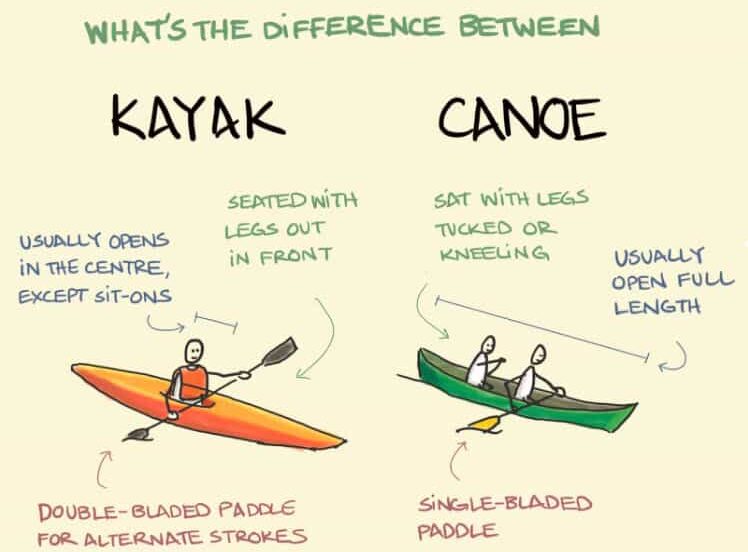Canoeing vs Kayaking: Main Differences & Benefits
Understanding the Basic Differences: Canoeing vs Kayaking
Are you ready to dive into the thrilling world of water sports? If so, canoeing and kayaking are two activities that should be on your radar.
These popular outdoor pastimes offer an exhilarating way for canoeists to explore rivers, lakes, and even oceans using recreational canoes and racing canoes as paddlecraft. But what sets them apart? And how do they compare in terms of boat types and paddling techniques?

The key differences lie in the boats used by canoeists and kayakers. Canoes typically feature an open design with higher sides, allowing for more space and accommodating multiple passengers.
On the other hand, kayaks have a closed cockpit design that provides better maneuverability and control for the kayaker. Both paddlecraft offer unique experiences on the water.
While both activities share similarities in their reliance on paddling techniques and paddlecraft, each has its unique characteristics. Canoeing, including racing canoes and recreational canoes, tends to prioritize teamwork as passengers work together to steer and propel the boat forward.
In contrast, kayaking, including racing kayaks, often leans towards solo exploration with individual paddlers navigating their own vessel.
Whether you prefer the camaraderie of canoeing or the independence of kayaking, these water sports, including top kayaks, offer endless opportunities for adventure seekers like yourself.
So grab your paddle and get ready for an unforgettable journey through nature’s watery playground! Whether it’s touring or sprint, these activities are perfect for people who love to explore.
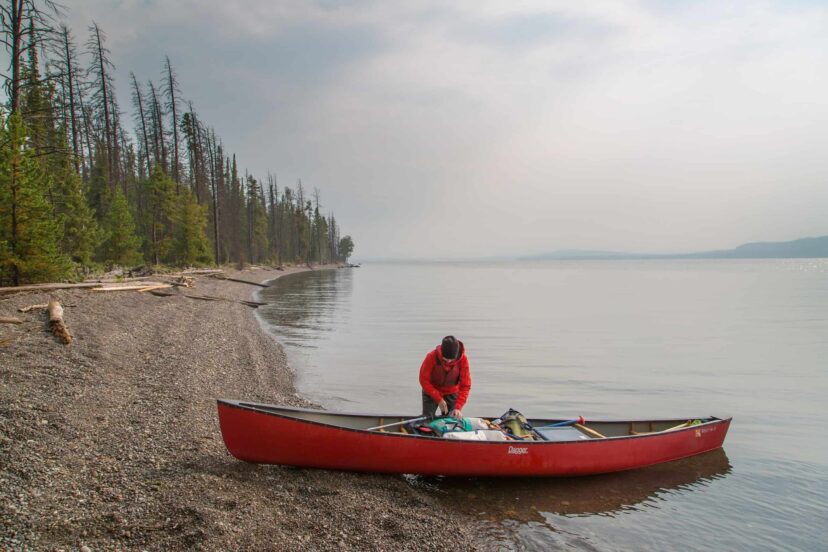
Types of Canoes and Kayaks
Various designs and materials used in canoe construction
Canoes come in a variety of designs, each suited for different purposes. One popular type is the average canoe, which is often made from durable materials like aluminum or fiberglass.
These canoes are great for recreational use, as they provide stability and ease of maneuverability on calm waters.
Another design option is the whitewater kayak, specifically built to withstand rough rapids and fast-moving rivers. These kayaks are typically constructed with high-density polyethylene or composite materials to ensure durability in challenging conditions.
Additionally, for touring people, a bladed paddle is recommended to enhance their experience. For those interested in sprinting, specialized kayaks are available for racing on flatwater.
Different types of kayaks, such as sit-on-top and touring kayaks
There are several options to choose from based on your preferences and intended use. Sit-on-top kayaks, average canoes, and recreational canoes are popular choices for beginners or those who want an easy entry and exit experience.
These kayaks have an open cockpit design that allows you to sit on top rather than being enclosed within the hull.
On the other hand, touring kayaks and sprint canoes are designed for longer trips and offer more storage space for gear. They have a closed cockpit design that provides better protection from splashes and waves.
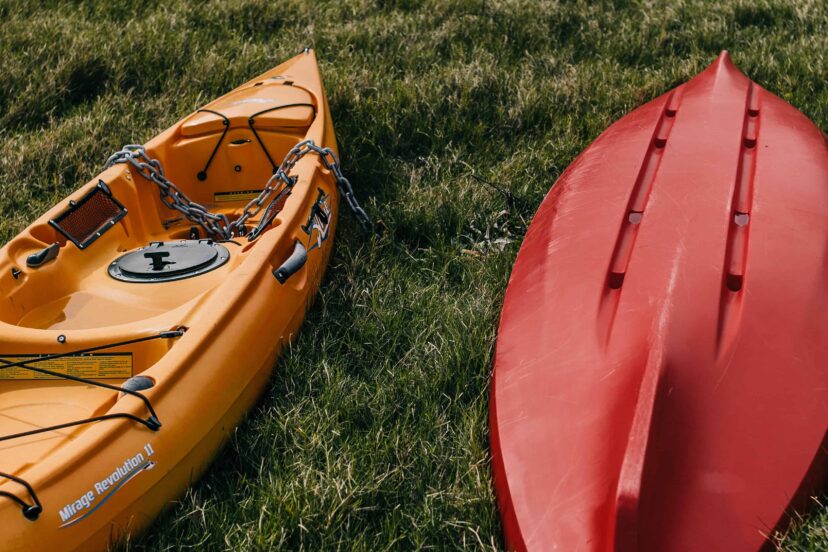
Factors to consider when choosing a canoe or kayak type
Deciding between a canoe or kayak requires considering various factors such as your skill level, intended use, budget, and storage capabilities. If you’re new to paddling, starting with a recreational canoe or sit-on-top kayak can be a good choice as they offer stability and ease of use.
However, if you plan on venturing into whitewater rafting or advanced paddling techniques, investing in specialized canoes or whitewater kayaks would be more suitable.
Specialized canoes and kayaks for specific purposes like whitewater rafting or fishing
For enthusiasts looking for specific experiences while paddling, there are specialized canoes and kayaks available catering to different purposes. Whitewater kayaks are designed with maneuverability and stability in mind, allowing paddlers to navigate through challenging rapids with ease.
Fishing kayaks, on the other hand, come equipped with features like rod holders, storage compartments, and stable platforms for anglers to enjoy their favorite pastime on the water.
Onboard Storage: Canoe vs Kayak Storage Space
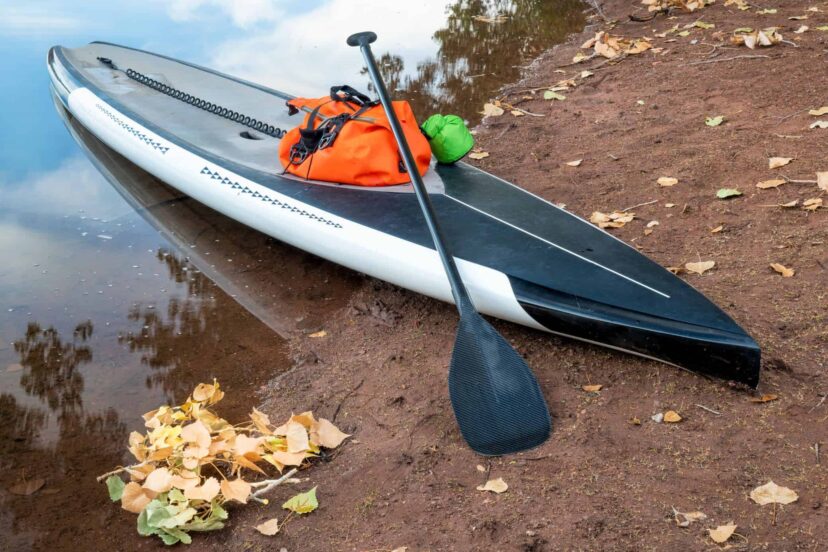
Ample storage capacity in canoes due to their open design
One of the major advantages of canoes over kayaks. Canoes have an open design, allowing for more gear and supplies to be stored comfortably. With a spacious interior and no cockpit restrictions, you’ll find plenty of room to stash your belongings.
When packing for a canoe or kayak trip, you can bring along larger items such as camping chairs, coolers, and even fishing gear without worrying about space constraints. The open layout also makes it easier to access your belongings during the journey.
Need a snack or want to grab your camera quickly? No problem! Just reach behind you and grab what you need without any hassle. Whether you’re using a kayak paddle, inflatable kayak, average kayak, or kayak singles, the spaciousness of the canoe ensures you have enough room for all your essentials.
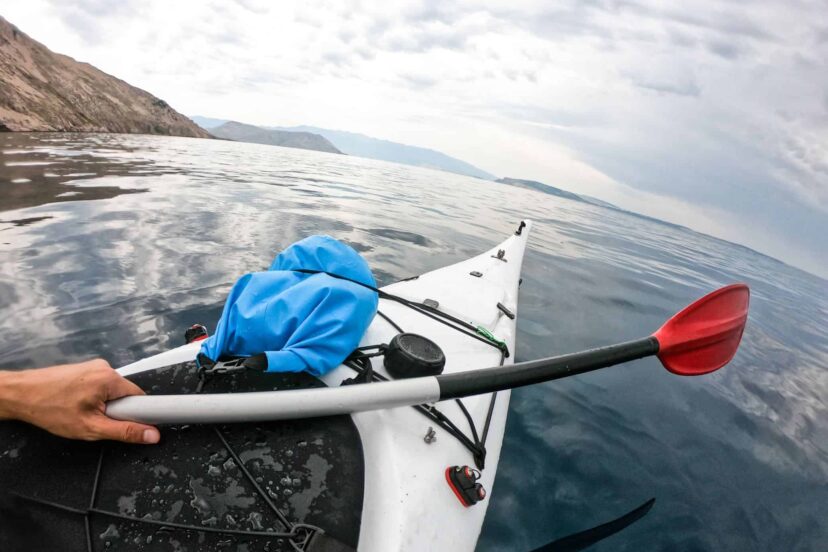
Limited storage options in most kayaks, especially sit-inside models
While canoes provide generous storage capacity, most kayaks have limited options in comparison. This is particularly true for sit-inside models where the paddler sits inside a closed cockpit. These kayaks typically have smaller compartments designed primarily for essentials like personal items or safety gear.
If you’re considering recreational canoe or kayak camping or embarking on longer trips with an average canoe that require more equipment and supplies, it’s essential to carefully plan your packing strategy.
You may need to prioritize what items are absolutely necessary and leave behind anything non-essential due to restricted storage space.
Importance of waterproof containers or bags for storing gear
Whether you choose canoeing or kayaking, one crucial aspect of onboard storage is ensuring that your gear stays dry throughout the journey. Water-resistant containers or bags are essential for protecting your belongings from getting soaked.

Investing in waterproof dry bags or containers will give you peace of mind knowing that even if water splashes into your inflatable kayak, kayak paddle, average kayak, kayak singles, your clothes, electronics, and other sensitive items will remain safe and dry.
These specialized bags come in various sizes to accommodate different gear, including inflatable kayak, kayak paddle, average kayak, and kayak singles, and they often feature a roll-top closure system to ensure a watertight seal.
Considerations when packing equipment and supplies for longer trips
When planning for longer canoe or kayak trips, it’s crucial to carefully consider what equipment and supplies you’ll need. Here are some key points to keep in mind:
-
Weight distribution: Distribute the weight evenly throughout the boat to maintain stability and maneuverability.
-
Essential items: Prioritize essential items such as food, water, safety gear, navigation tools, and personal items.
-
Clothing: Pack appropriate clothing for the weather conditions you expect during your trip.
-
Cooking equipment: If you plan on cooking meals during your journey, pack lightweight camping stoves, cookware, and utensils.
-
Sleeping arrangements: Consider compact sleeping bags or hammocks if overnight stays are part of your adventure.
Remember that each canoe or kayak has its own weight capacity limit specified by the manufacturer. Exceeding this limit can compromise safety and performance.
Comfort Comparison: Kayak vs Canoe Seats and Overall Comfort
Ergonomic seats with backrests in many modern kayak designs
One of the key factors to consider is the seating arrangement. Modern kayak designs often feature ergonomic seats with built-in backrests, providing excellent lumbar support for long hours on the water. These backrests are designed to mold to your body shape, ensuring a comfortable paddling experience.
In contrast, canoes traditionally have bench-style seating without backrests. However, it’s worth noting that some canoe models now offer adjustable seating positions that allow you to customize your comfort level. This flexibility enables you to find a comfortable position based on your preferences and body type.
Cushioned seats and padding options to enhance comfort
Another aspect that contributes to overall comfort is the cushioning provided in both kayaks and canoes. Many kayak models come equipped with padded seats, offering extra cushioning for extended trips or rough waters. These cushioned seats help alleviate pressure points and provide additional support during long hours of paddling.
Similarly, canoe enthusiasts have the option of adding seat cushions or pads for enhanced comfort. These accessories come in various thicknesses and materials, allowing you to choose what works best for you. Whether it’s foam padding or inflatable cushions, these additions can significantly improve your comfort level while canoeing.
Personal preferences influencing the choice between kayak or canoe comfort
Comfort is subjective and varies from person to person. When deciding between kayaking and canoeing based on comfort alone, personal preferences play a crucial role. Some individuals may find kayaks more comfortable due to their ergonomic design and supportive backrests. On the other hand, others may prefer the open space offered by canoes despite their lack of built-in backrests.
To determine which option suits you best in terms of comfort, consider factors such as:
-
Body posture: Do you prefer sitting upright or reclined?
-
Support needs: Do you require additional back support or cushioning due to any existing conditions?
-
Paddling style: Are you more comfortable with a double-bladed paddle (kayak) or a single-bladed paddle (canoe)?
-
Water conditions: Will you be paddling in calm lakes, rivers, or rougher waters?
By taking these factors into account, you can make an informed decision that aligns with your comfort preferences.
Paddling Differences: Canoes vs Kayaks
Different Paddle Styles
One of the key distinctions between canoeing and kayaking lies in the type of paddles used. In canoes, paddlers typically employ single-bladed paddles, while kayakers opt for double-bladed ones. The choice of paddle is influenced by the design and purpose of each watercraft.
Unique Paddling Techniques
Paddling a canoe requires a different technique compared to kayaking. Canoeists use a “J-stroke” technique to maintain a straight course. This involves a combination of forward strokes on one side and corrective strokes on the other. On the other hand, kayakers utilize a symmetrical stroke technique known as the “forward sweep,” which allows them to navigate with precision.
Maneuverability Advantages of Kayaks
Kayaks offer superior maneuverability due to their narrower profile. With their sleek design, kayaks can easily slice through water, making tight turns and swift maneuvers possible. This agility makes them ideal for activities such as whitewater rafting or exploring narrow waterways where quick changes in direction are necessary.
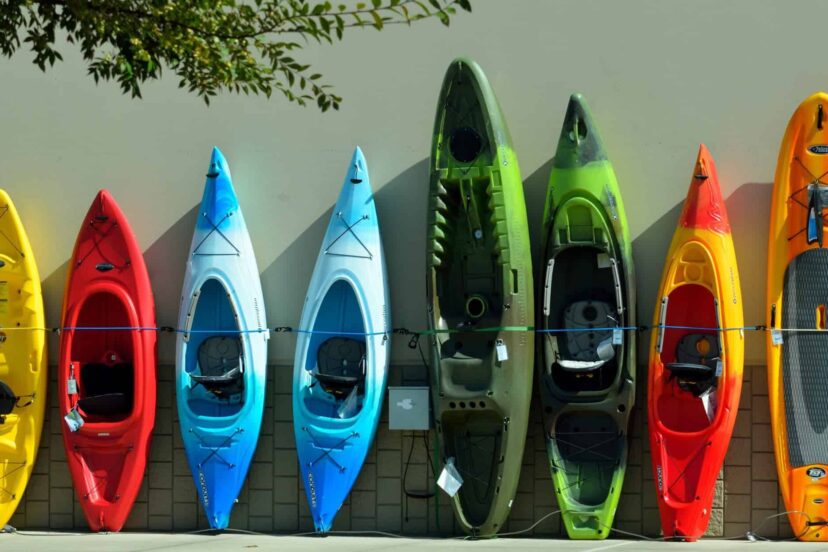
Stability Benefits of Canoes
In contrast to kayaks, canoes generally provide greater stability due to their wider hull design. The broad base ensures better balance on calm waters, making it easier for beginners or those seeking a more relaxed paddling experience. Canoes have ample space for gear storage, making them suitable for extended trips or fishing excursions.
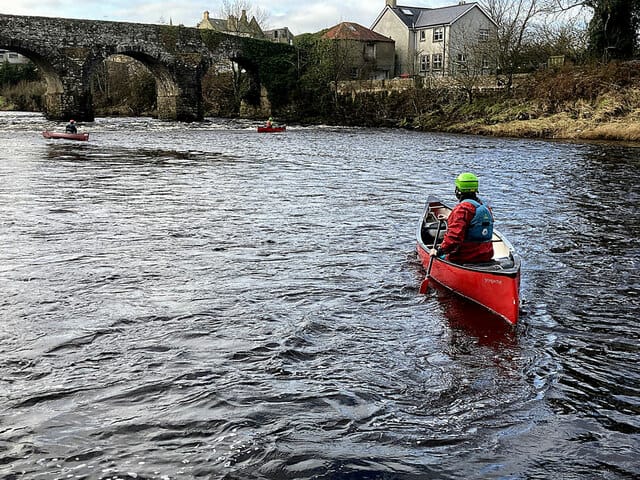
Understanding these fundamental differences will help you make an informed decision based on your preferences and intended use:
-
If you prioritize speed and agility while navigating through challenging waters or participating in adrenaline-fueled adventures like whitewater rafting, then kayaking might be your best bet.
-
On the other hand, if you value stability and prefer leisurely trips on calm lakes or rivers, canoeing could be the perfect choice for you.
Ultimately, both paddlecraft offer unique experiences and can be enjoyed by paddlers of all skill levels. Whether you prefer the nimble maneuverability of a kayak or the steady stability of a canoe, there’s no shortage of opportunities to explore and enjoy the beauty of nature from the water.
So grab your paddle, hop in your chosen vessel, and embark on an unforgettable adventure as you glide across serene waters or conquer thrilling rapids – the choice is yours!
Pros and Cons of Fishing in a Canoe and Kayak
Quiet Approach Favored by Anglers
One of the major advantages of both canoes and kayaks. These boats are designed to glide silently through the water, ensuring that you don’t scare away any fish with loud noises. Whether you choose a canoe or kayak, you’ll be able to sneak up on your target without alerting them to your presence.
Enhanced Stability Offered by Canoes
Canoes take the lead. With their wider hulls and flat bottoms, canoes offer excellent stability, allowing anglers to stand up comfortably while casting lines or reeling in their catch. This added stability makes canoes an ideal choice for those who prefer a solid base while battling feisty fish.
Ease of Maneuverability Provided by Kayaks

On the other hand, kayaks excel in maneuverability. Their sleek design and lower profile make them easier to navigate through narrow waterways and tight spots where fish might be hiding. If you enjoy exploring smaller rivers or want the freedom to quickly change fishing locations, a kayak might be the better option for you.
Consideration of Personal Preferences
Ultimately, choosing between canoeing and kayaking for fishing purposes boils down to personal preferences. Some anglers value stability above all else and appreciate the spaciousness offered by canoes. Others prioritize maneuverability and find that kayaks suit their needs better.
It’s essential to consider factors such as body size, comfort levels, storage capacity requirements, and even aesthetics when making your decision.
Now let’s take a closer look at some pros and cons of both canoeing and kayaking:
Pros of Canoeing:
-
Excellent stability allows for comfortable standing positions while fishing.
-
Ample space for gear storage.
-
Suitable for larger groups or anglers who prefer fishing with a partner.
-
Can be paddled solo or tandem.
Cons of Canoeing:
-
Requires more effort to paddle due to its larger size and heavier weight.
-
Slower speed compared to kayaks.
-
More susceptible to wind and current.
Pros of Kayaking:
-
Superior maneuverability, making it easier to navigate tight spots and narrow waterways.
-
Lightweight and easy to transport, especially for solo anglers.
-
Faster speed allows for quicker access to fishing spots.
-
Increased responsiveness.
Cons of Kayaking:
-
Less stability compared to canoes, making standing positions more challenging.
-
Limited storage space for gear and equipment.
-
Solo kayaking might not be as enjoyable for those who prefer fishing with others.
In the end, whether you choose canoeing or kayaking for your fishing adventures depends on what aspects are most important to you. Consider your preferences in terms of stability, maneuverability, storage capacity, and the overall experience you desire. Both options offer unique advantages that can enhance your fishing trips.
Speed and Stability Comparison: Canoe vs Kayak
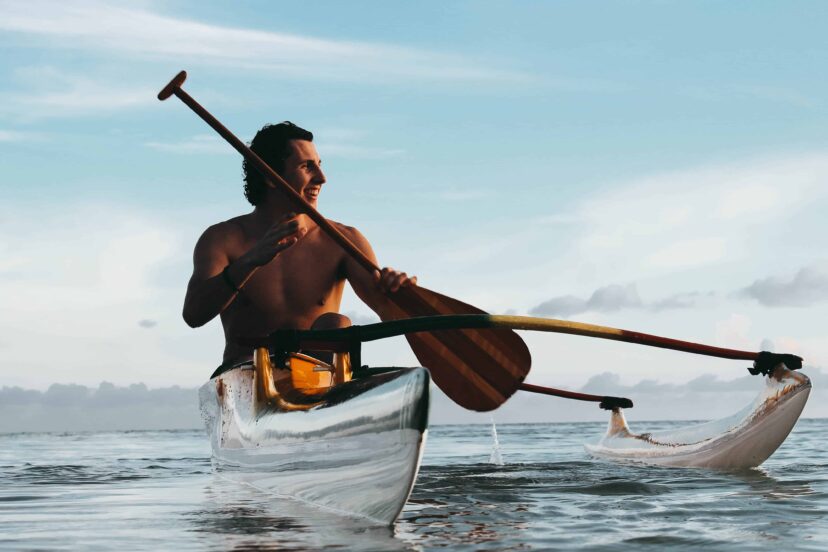
Faster speeds achievable with kayaks due to their streamlined shape
Kayaks are known for their sleek and streamlined design, allowing them to glide through the water with ease. The narrow hull of a kayak reduces drag, enabling it to achieve higher speeds compared to canoes. This makes kayaks an excellent choice for those seeking a thrilling and fast-paced experience on the water.
With their lower profile, kayaks offer less wind resistance, further enhancing their speed capabilities. Whether you’re paddling across a calm lake or challenging rapids in a river, the aerodynamic nature of a kayak allows you to cut through the water effortlessly. This increased speed can be particularly advantageous for competitive racing or simply covering more distance in less time.
Enhanced stability offered by canoes, making them suitable for beginners
While kayaks excel in speed, canoes provide superior stability. The wider and open design of canoes offers a more balanced platform, making them ideal for beginners or individuals who prefer a relaxed and stable paddling experience.
Canoes have a larger surface area on the water, providing better buoyancy and stability even in rougher conditions. This stability is especially beneficial when fishing or carrying additional gear during camping trips. The higher sides of canoes help prevent water from splashing into the boat, ensuring a drier ride.
Impact of water conditions on the speed and stability of both boats
Water conditions play a significant role in determining how both canoes and kayaks perform in terms of speed and stability. Calm waters allow kayakers to fully exploit their vessel’s streamlined shape and achieve impressive speeds. On the other hand, choppy waters may pose challenges as waves could affect balance and control.
Canoes shine in windy conditions where their broader structure provides increased resistance against gusts that could potentially tip over smaller kayaks. However, this advantage comes at the cost of speed, as the wider hull creates more drag in calmer waters.
Trade-offs between speed and stability when selecting a boat
When choosing between canoeing and kayaking, it’s essential to consider your priorities. If speed is your primary concern and you’re comfortable with a narrower vessel that requires more balance, then kayaking is the way to go. On the other hand, if stability and ease of use are more important to you, then canoeing would be a better fit.

Ultimately, both canoes and kayaks offer unique advantages depending on your preferences and intended use. Whether you’re seeking an adrenaline-filled adventure or a leisurely paddle on tranquil waters, understanding the trade-offs between speed and stability will help guide your decision.
Choosing the Right Boat – Canoe or Kayak
Factors to consider when deciding between a canoe or kayak
Choosing between a canoe and a kayak can be a tough decision, but considering a few key factors can help you make the right choice. Here are some important things to think about:
-
Personal preferences: Think about what type of experience you’re looking for on the water. Canoes provide more space and allow for easier movement, making them great for recreational trips with family and friends. On the other hand, kayaks offer better maneuverability and are often preferred by those seeking speed and agility.
-
Intended use: Consider how you plan to use your boat. If you’re interested in fishing or camping trips that require carrying gear, a canoe’s larger capacity may be more suitable. However, if you’re into adventurous activities like whitewater rafting or racing, a kayak’s sleek design and maneuverability might be ideal.
-
Skill level: Evaluate your paddling skills honestly. Canoes generally offer more stability due to their wider shape, making them beginner-friendly. Kayaks, especially racing models, require more skill to handle properly but offer greater speed once mastered.
-
Trying out different models: It’s essential to try out various canoe and kayak models before making your final decision. Renting or borrowing different types will give you a hands-on experience of their differences in size, weight distribution, stability, and comfort.
-
Seeking advice from experienced paddlers: Reach out to experienced paddlers or professionals who can provide valuable insights based on their own experiences with both canoes and kayaks. They may have helpful tips specific to your needs or preferences that could influence your decision-making process.
Examples:
-
Average kayaks: Wilderness Systems Pungo 120, Perception Pescador Pro 12
-
Racing kayaks: Epic V7 Surfski, Nelo 520
-
Recreational canoes: Old Town Discovery 158, Wenonah Spirit II
-
Inflatable kayaks: Advanced Elements AdvancedFrame Convertible, Sea Eagle 370 Pro
-
Dugout canoe: Traditional wooden canoe carved from a single tree trunk
Remember, choosing the right boat ultimately depends on your personal preferences, intended use, and skill level. Trying out different models and seeking advice from experienced paddlers will help you make an informed decision. So whether you opt for a sleek kayak or a spacious canoe, get ready to enjoy the thrill of gliding across the water in your chosen vessel!
Getting Up Close & Personal with Canoes and Kayaks
Opportunities for Wildlife Observation while Canoeing or Kayaking
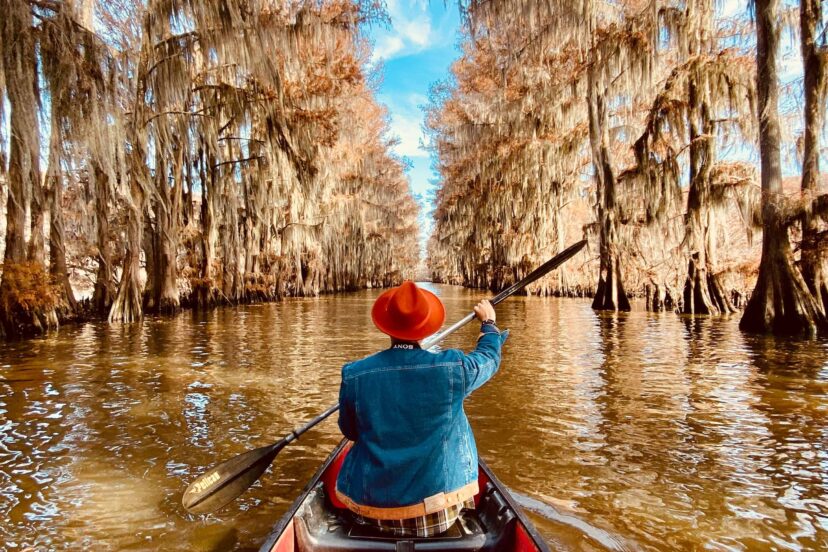
Canoes and kayaks offer unique opportunities to get up close and personal with wildlife. As you paddle through calm waterways, you can quietly approach various species without disturbing them. Whether it’s a family of ducks gliding across the surface or a majestic heron perched on the shoreline, canoeing and kayaking allow you to observe these beautiful creatures in their natural habitats.
Imagine silently gliding through a marshland, surrounded by lush vegetation and listening to the sounds of nature. Canoes and kayaks provide an intimate experience that larger boats simply cannot match. With their sleek designs, kayakers can maneuver effortlessly through narrow channels, exploring hidden corners where motorized watercraft cannot venture.
Ability to Explore Narrow Waterways Inaccessible by Larger Boats
One of the greatest advantages of canoeing and kayaking is the ability to explore narrow waterways that are inaccessible to larger boats. These vessels are designed specifically for navigating shallow rivers, winding streams, and tight passages. With their agile maneuverability, they can weave through obstacles like fallen trees or rocks with ease.
If you’re an adventurous soul seeking thrilling experiences, whitewater kayaking might be your calling. Tackle rapids as you navigate down fast-flowing rivers, feeling the rush of adrenaline as you conquer each rapid. For those who prefer a more relaxed pace, touring kayaks provide stability and comfort for extended trips along calm lakes or coastal areas.
Enjoyment of Serene Natural Surroundings during Paddling Adventures
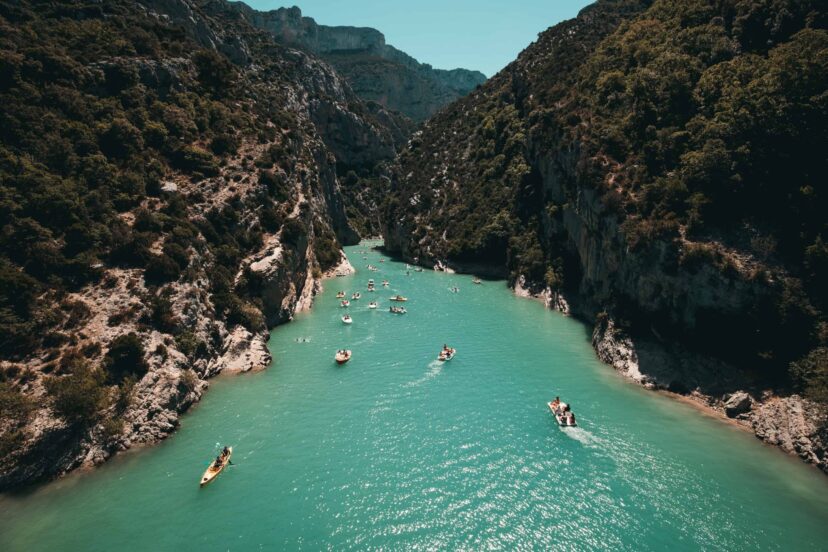
There’s something truly magical about paddling in serene natural surroundings. Whether it’s a tranquil lake nestled among mountains or a meandering river cutting through dense forests, canoeing and kayaking offer unparalleled opportunities to immerse yourself in nature’s beauty.
Picture yourself gliding over crystal-clear waters while being surrounded by breathtaking landscapes. The rhythmic sound of your paddle dipping into the water creates a soothing melody that harmonizes with the sounds of birds chirping and leaves rustling in the wind. This connection with nature is a rejuvenating experience for both the mind and soul.
Benefits of Low Impact on the Environment Compared to Motorized Watercraft
Unlike motorized watercraft, canoes and kayaks have a minimal impact on the environment. They operate silently without emitting harmful fumes or disturbing aquatic life. By choosing these non-motorized options, you contribute to preserving delicate ecosystems while enjoying your paddling adventures guilt-free.
Kayak singles and inflatable kayaks are lightweight and easily transportable, making them an eco-friendly choice for those who value sustainability. You can explore various bodies of water without leaving behind a significant carbon footprint.
Stability Comparison: Kayaks vs Canoes
Wider hull design providing greater initial stability in canoes

Canoes are known for their wider hull designs, which offer excellent initial stability. This means that when you first step into a canoe, you’ll feel more secure and balanced. The wide base creates a solid platform, making it easier to stay upright and maintain stability while paddling. Whether you’re navigating calm waters or encountering mild waves, the wider hull of a canoe helps keep you steady.
Secondary stability advantages offered by narrower kayak profiles
On the other hand, kayaks have narrower profiles compared to canoes. While this may initially seem less stable, it actually offers secondary stability advantages. Secondary stability refers to how well a boat handles when leaned on its side. Kayaks with narrower profiles allow for better maneuverability and responsiveness in rougher waters or during quick turns.
Balancing techniques required for maintaining stability in both boats
Both canoes and kayaks require balancing techniques to maintain stability while on the water. In a canoe, proper weight distribution is crucial. By positioning yourself correctly within the boat and distributing weight evenly between bow and stern, you can enhance stability. Using your paddle as a stabilizer by placing it across the gunwales (the upper edges of the canoe) can help maintain balance.
In kayaking, mastering your body’s center of gravity is key to staying stable. By engaging your core muscles and keeping your body centered over the kayak’s cockpit, you’ll be able to maintain balance even in challenging conditions. Learning how to brace with your paddle will also provide additional support and help prevent capsizing.
Consideration of personal comfort levels when choosing a stable boat
When deciding between a kayak or canoe based on stability, it’s essential to consider personal comfort levels as well. Some individuals may feel more at ease with the initial stability provided by wider canoes, while others may prefer the maneuverability and secondary stability of narrower kayaks. It’s important to try both types of boats and assess which one feels more comfortable and secure for your specific needs.
Getting into the Boat: Differences in Design
Easy Access with Open-Top Kayaks
Many modern designs offer easy access thanks to their open-top design. Unlike canoes, which have a higher deck and enclosed sides, kayaks typically have a lower profile with an open cockpit. This allows paddlers to simply step into the kayak from a dock or shoreline without any hassle. Whether you’re a beginner or an experienced paddler, this feature makes kayaking more accessible and convenient.
Stepping Into Canoes with Proper Technique
On the other hand, canoes require a slightly different approach. Due to their higher deck and enclosed sides, stepping into a canoe requires proper technique and balance. To enter a canoe safely, start by positioning yourself beside the boat on either side. Then, place one foot inside while holding onto the gunwales for stability. Slowly lower yourself down into the canoe while maintaining balance and weight distribution.
Importance of Balance and Weight Distribution
No matter whether you’re entering a kayak or canoe, balance and weight distribution are crucial elements to consider. In both watercrafts, maintaining proper balance ensures stability while paddling. When stepping into either vessel, be mindful of your center of gravity and distribute your weight evenly to avoid tipping over.
Variations in Entry Methods Depending on Boat Features
While we’ve discussed general entry techniques for kayaks and canoes, it’s important to note that there are variations depending on individual boat features. For example:
-
Sit-on-top kayaks: These kayaks offer even easier access as they have no enclosed cockpit at all. Simply step onto the kayak from any stable surface.
-
Recreational kayaks: Some recreational kayaks have larger cockpits that allow for easier entry compared to touring or sea kayaks.
-
Whitewater kayaks: Whitewater kayaks have a snugger fit to ensure better control in turbulent waters. Getting into these kayaks may require a bit more flexibility and practice.
-
Solo canoes: Solo canoes often have lower decks, making entry similar to that of a kayak.
-
Tandem canoes: Tandem canoes are wider and more stable, making it easier to step in without losing balance.
Remember, the design differences between kayaks and canoes are intended for different styles of paddling and their intended uses. Kayaks excel in maneuverability, speed, and versatility, while canoes offer greater stability and storage capacity.
Adventure Preferences: Choosing the Right Boat
Versatility advantages offered by kayaks for various water activities
Kayaks are like the Swiss Army knives of the boating world. With their sleek design and maneuverability, they offer a wide range of possibilities for adventure seekers. Whether you’re into fishing, whitewater rafting, or just leisurely paddling on calm waters, kayaks have got you covered.
Here are some examples of the versatility advantages that kayaks bring to the table:
-
Fishing: Kayaks designed specifically for fishing come equipped with rod holders and storage compartments to keep your gear organized. You can silently glide through shallow waters and reach those secret fishing spots that larger boats can’t access.
-
Whitewater rafting: If you’re an adrenaline junkie craving excitement, kayaking through rapids is an experience like no other. The narrow profile of a kayak allows it to navigate swiftly through turbulent waters, giving you an exhilarating ride.
-
Leisurely paddling: For those seeking a peaceful escape on calm lakes or rivers, recreational kayaking offers a serene experience. You can explore hidden coves, observe wildlife up close, and enjoy the tranquility of nature at your own pace.
Exploration opportunities provided by canoes in calm lakes or rivers
While kayaks excel in versatility, canoes have their own charm. Canoes offer stability and ample space for carrying gear or even bringing along a furry companion.
Here’s why choosing a canoe might be ideal for your exploration adventures:
-
Space and comfort: Canoes provide more room than kayaks, making them suitable for longer trips where extra gear or passengers need to be accommodated comfortably. You can pack camping equipment, coolers filled with food and drinks, and still have enough space to stretch out during your journey.
-
Teamwork and bonding: Canoeing is often a shared experience, perfect for couples, families, or groups of friends. Paddling together in sync requires coordination and communication, fostering teamwork and creating lasting memories.
-
Peaceful cruising: Canoes glide smoothly through calm waters, allowing you to take in the surrounding beauty without much effort. You can leisurely paddle along the shoreline, admiring the scenery and wildlife as you go.
Consideration of specific adventure goals when selecting a boat
Your personal preferences and adventure goals should be at the forefront of your decision-making process. Each type of boat offers unique advantages that cater to different experiences on the water.
Here are some factors to consider before making your choice:
-
Solo or group outings: If you prefer going solo or with one companion, a kayak might be more suitable due to its maneuverability. However, if you enjoy sharing your adventures with others, a canoe allows for more space and easier collaboration.
-
Distance and duration: For longer trips where storage capacity is crucial, canoes have an advantage with their larger size. Kayaks are better suited for shorter excursions or activities that require agility.
Transporting Your Boat: Ease of Transport Comparison
Lighter Weight and Compact Size
One of the key factors to consider is the weight and size.
Kayaks have a clear advantage. They are generally lighter in weight compared to canoes, making them easier to handle and carry. With their sleek design and compact size, kayaks can be easily loaded onto roof racks or even fit inside the trunk of a car. You won’t need a massive truck or trailer to transport your kayak; a small vehicle will do just fine.
Additional Equipment Required
Both canoes and kayaks require some additional equipment for transportation purposes. While kayaks may be easier to load due to their smaller size, you’ll still need roof racks or kayak carriers to secure them safely on top of your vehicle. These accessories ensure that your kayak remains stable during transportation.
On the other hand, canoes tend to be bulkier and heavier than kayaks. To transport a canoe, you might need a trailer specifically designed for boats or invest in foam blocks and straps if you plan on using roof racks. The additional equipment required for canoes adds an extra step and expense compared to kayaks.
Vehicle Limitations
Before heading out with your canoe or kayak, it’s essential to consider your vehicle’s limitations. Different vehicles have varying load capacities that determine how much weight they can safely carry on the roof or tow behind them.
If you own a smaller car with limited load capacity, transporting a heavy canoe may not be feasible without exceeding your vehicle’s limits. In such cases, opting for a lighter kayak could be more suitable as it puts less strain on your vehicle.
Proper Securing Techniques
Regardless of whether you choose canoeing or kayaking, proper securing techniques are crucial for safe transportation. Failing to secure your boat adequately can lead to accidents on the road or damage to your vehicle and equipment.
For both canoes and kayaks, it’s recommended to use sturdy straps or ropes to tie them down securely. Make sure the boat is centered and balanced on your roof racks or trailer, minimizing any potential movement during transit. Double-check all connections before hitting the road to ensure everything is tightly secured.
Disadvantages of a Canoe and a Kayak
Vulnerability to wind and currents due to the open design of canoes
One major disadvantage of both canoes and kayaks is their vulnerability to wind and currents. Canoes, with their open design, are more susceptible to being blown off course by strong winds. This can make it challenging to maintain control and navigate effectively. Similarly, kayaks, although more streamlined than canoes, can still be affected by gusts of wind or strong currents. Paddlers need to be prepared for these conditions and adjust their technique accordingly.
Limited storage space in most kayak models
Another drawback of both canoes and kayaks is the limited storage space available. While some kayak models may offer additional compartments or hatches for storing gear, the overall capacity is often smaller compared to other watercraft options. This constraint can pose challenges for longer trips or when carrying bulky items such as camping gear or extra supplies. Paddlers must carefully plan and prioritize what they bring on their journeys.
Potential discomfort during long periods of paddling in either boat type
Prolonged periods of paddling in both canoes and kayaks can lead to discomfort for the paddler. Sitting in a fixed position for an extended time may cause muscle fatigue, stiffness, or even cramps. Without proper padding or support, sitting on hard surfaces like canoe benches or kayak seats can become uncomfortable over time. It’s essential for paddlers to take breaks, stretch regularly, and invest in comfortable seating options if planning extended outings.
Challenges associated with solo paddling in larger canoes
While solo paddling is possible in both canoeing and kayaking, larger canoes present unique challenges when operated by a single person. The size and weight of larger canoes make them more difficult to maneuver alone compared to smaller ones designed specifically for solo use.
Paddling alone in a larger canoe may require more effort and skill to maintain control and navigate effectively. It’s important for solo paddlers to be experienced and confident in their abilities before attempting to paddle larger canoes alone.
Which is Better? Canoe vs Kayak: Final Verdict
No Definitive Answer as the Choice Depends on Personal Preferences
There is no definitive answer as to which one is better. The choice ultimately depends on personal preferences and what you are looking for in a watercraft experience. Both canoeing and kayaking offer unique advantages and disadvantages, so it’s important to consider your own needs before making a decision.
Consideration of Intended Use, Skill Level, and Specific Requirements
To determine whether a canoe or kayak is the best fit for you, it’s essential to consider your intended use, skill level, and specific requirements. Canoes are generally more spacious and can accommodate multiple people or larger gear loads, making them ideal for family outings or extended camping trips.
On the other hand, kayaks are sleeker and designed for individual use, offering greater maneuverability and speed.
If you plan on exploring calm lakes or slow-moving rivers with friends or family members, a canoe may be the better option. It allows for easy conversation and shared experiences while gliding through the water.
However, if you prefer tackling whitewater rapids or embarking on solo adventures where agility is key, then a kayak might be more suitable.

Advantages and Disadvantages Weighed Against Individual Needs
Let’s delve into some of the advantages and disadvantages of both canoes and kayaks:
Canoe Advantages:
-
Spaciousness allows for comfortable seating arrangements
-
Greater stability makes it easier to fish or take photographs
-
Versatility in handling different types of water conditions
-
Ability to carry more gear or passengers
Canoe Disadvantages:
-
Slower speed compared to kayaks due to their larger size
-
More prone to wind resistance
-
Requires teamwork when paddling with others
-
Heavier weight can be challenging to transport
Kayak Advantages:
-
Excellent maneuverability and speed
-
Suitable for solo adventures or small groups
-
Lighter weight makes it easier to transport
-
Better performance in windy conditions
Kayak Disadvantages:
-
Limited storage space for gear and equipment
-
Less stability, especially in larger bodies of water
-
Solo paddling may not be ideal for everyone
-
Smaller seating area may be less comfortable for longer trips
Encouragement to Try Both Canoeing and Kayaking Experiences Before Deciding
In this canoe vs kayak debate, the best way to make an informed decision is by trying both experiences firsthand. Renting or borrowing a canoe and kayak will allow you to get a feel for each watercraft’s handling, stability, and comfort. By experiencing both activities, you can better understand which one aligns with your personal preferences and suits your needs.
Remember that while there are general advantages and disadvantages associated with canoes and kayaks, individual models within each category may offer unique features that could sway your decision. It’s always a good idea to do some research on specific models before making a purchase.
Conclusion: Canoeing vs Kayaking
In conclusion,It ultimately depends on your personal preferences and needs. Both activities offer unique experiences on the water, and understanding the key differences can help you make an informed decision.
Types of Canoes and Kayaks vary in design and purpose. Canoes are typically open-top boats with a higher weight capacity, while kayaks have closed cockpits that provide better protection from splashing water. Consider your intended use and the type of water you’ll be paddling in when selecting a boat.
Onboard Storage is an important factor to consider. Canoes generally have more storage space, making them suitable for longer trips or carrying larger gear. However, kayaks often have compartments or hatches that allow for organized storage within the boat itself.
Comfort Comparison is another aspect to keep in mind. Kayaks usually have more ergonomic seats that provide better back support, making them more comfortable for extended periods of paddling. Canoe seats may require additional padding or adjustments for optimal comfort.
Paddling Differences also exist between canoes and kayaks. Canoes are propelled using single-bladed paddles, requiring alternating strokes on either side of the boat. On the other hand, kayaks use double-bladed paddles for a more efficient forward stroke.
Pros and Cons of Fishing in a Canoe and Kayak should be considered if fishing is your main intention. While both options can be used for fishing, canoes offer more stability for casting lines or standing up while kayaks provide better maneuverability in narrow spaces.
Speed and Stability Comparison reveals that kayaks tend to be faster due to their sleek design, while canoes offer greater stability on calm waters. Decide whether speed or stability is more important based on your desired activities.
Choosing the Right Boat involves considering factors such as skill level, intended use (recreational or touring), and the type of water you’ll be paddling in. Take into account your preferences and needs to make an informed decision.
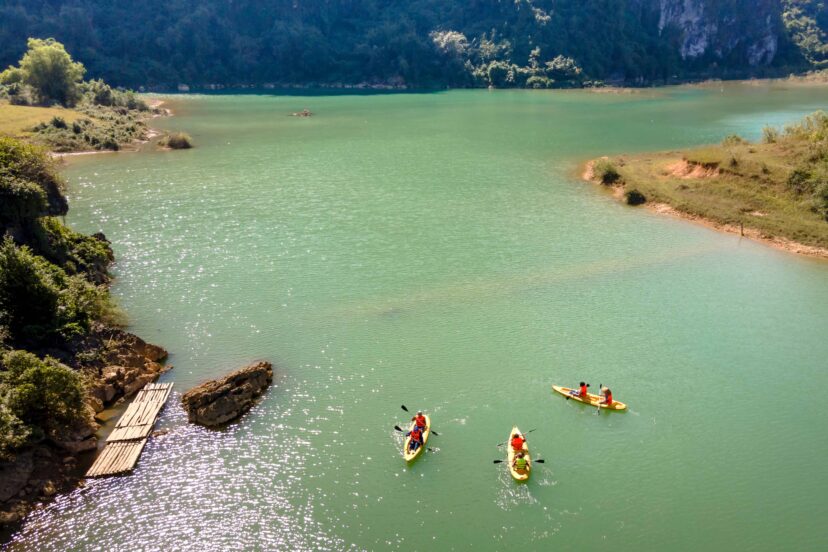
Getting Up Close & Personal with Canoes and Kayaks allows you to appreciate the unique experiences each activity offers. Canoeing provides a more open and communal experience, while kayaking can offer a sense of solitude and better maneuverability.
Stability Comparison reveals that kayaks are generally more stable due to their lower center of gravity, making them less likely to tip over. However, with practice and proper technique, canoes can also provide stability on the water.
Getting into the Boat: Differences in Design should be considered when choosing between canoeing and kayaking. Canoes have an open design that allows for easy entry from either side, while kayaks require sliding into the cockpit from above.
Adventure Preferences play a significant role in selecting the right boat. If you prefer exploring calm lakes or slow-moving rivers, canoeing may be ideal for you. On the other hand, if you enjoy tackling rapids or venturing into coastal waters, kayaking might be more suitable.
Transporting Your Boat is another factor to consider. Canoes are often larger and heavier than kayaks, requiring additional effort when transporting them on car racks or trailers. Ensure that your chosen boat is compatible with your transportation method.
Disadvantages of a Canoe and a Kayak include limitations such as difficulty in maneuvering through tight spaces for canoes or potential discomfort during long periods of paddling for kayaks. Be aware of these drawbacks before making your decision.
Which is Better? Canoe vs Kayak: Final Verdict ultimately depends on your personal preferences, intended use, skill level, and desired experiences on the water. There is no definitive answer as both options offer unique advantages depending on individual needs.
In conclusion, take some time to try out both canoeing and kayaking if possible before making your final decision. Consider renting or borrowing different types of boats to get a feel for what suits you best. Remember, the most important aspect is to have fun and enjoy your time on the water.

